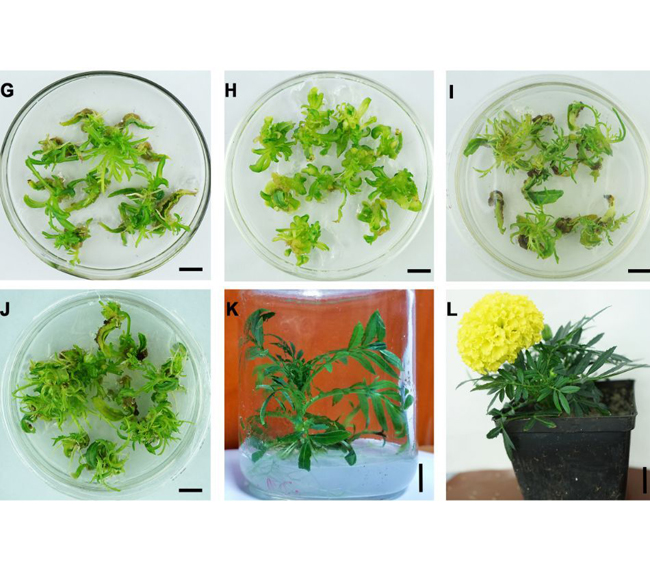- 1华中农业大学园艺林学学院, 园艺植物生物学教育部重点实验室, 武汉 430070
2武汉市汉阳市政建设集团有限公司, 武汉 430050
收稿日期: 2020-04-16
录用日期: 2020-08-26
网络出版日期: 2020-08-26
基金资助
中央高校基本科研业务费专项(2662019PY072);国家自然科学基金(31672181)
The Establishment and Optimization of a Regeneration System for Marigold (Tagetes erecta)
- 1Key Laboratory of Horticultural Plant Biology, Ministry of Education, College of Horticulture and Forestry Sciences, Huazhong Agricultural University, Wuhan 430070, China
2Wuhan Hanyang Municipal Construction Group Co, Ltd, Wuhan 430050, China
Received date: 2020-04-16
Accepted date: 2020-08-26
Online published: 2020-08-26
摘要
以40个不同基因型万寿菊(Tagetes erecta)叶片为外植体, 在相同条件下诱导不定芽分化, 获得最佳再生基因型; 然后分析不同激素组合、外植体切口方式、固化剂及蔗糖对万寿菊再生和玻璃化影响; 最后对不同类型的伸长培养基进行探索。结果表明, 最佳再生基因型为里程碑·黄色; 最佳再生培养基为MS+0.2 mg·L‒1 TDZ+0.5 mg·L‒1 IBA+8 g·L‒1琼脂+40 g·L‒1蔗糖, 再生率达70%, 玻璃化率降低至16%; 最适再生的小叶部位为全小叶; 最适伸长培养基为MS+8 g·L‒1琼脂+30 g·L‒1蔗糖, 伸长率达91.3%。该研究建立了高效稳定的万寿菊再生体系, 解决了万寿菊再生过程中严重的玻璃化问题, 可为万寿菊的遗传改良和基因功能研究奠定基础。

本文引用格式
王亚琴 , 韦陆丹 , 王文静 , 刘宝骏 , 张春玲 , 张俊卫 , 何燕红 . 万寿菊再生体系的建立及优化[J]. 植物学报, 2020 , 55(6) : 749 -759 . DOI: 10.11983/CBB20062
Abstract
In this study, marigold (Tagetes erecta) leaves of 40 different genotypes were used as explants to induce adventitious buds formation to select the best regenerating genotype. In addition, main factors impacting the selected genotype’s regeneration and vitrification were analyzed, including hormone combinations, the way of explant incision, curing agent and sucrose, etc. Finally, different types of elongation medium were explored. The best regenerated genotype was marigold Milestone·Yellow. The best regeneration medium was MS media supplied with 0.2 mg·L‒1 TDZ, 0.5 mg·L‒1 IBA, 8 g·L‒1 agar, and 40 g·L‒1 sucrose, in which the regeneration rate was 70% and the vitrification rate was reduced to 16%. Whole leaflet was the most suitable explant among different leaflet segments; the best performing elongation medium was MS media supplied with 8 g·L‒1 agar and 30 g·L‒1 sucrose, and the elongation rate was 91.3%. This study establishes an efficient and stable regeneration system of marigold, and solved the serious vitrification problem commonly found during regeneration. It laid a foundation for marigold genetic improvement and gene function research.

Key words: marigold (Tagetes erecta); regeneration; genotype; vitrification
参考文献
| [1] | 陈兵先, 黄宝灵, 吕成群, 杨来安, 陈文军, 任苓, 王劲松 (2011). 植物组织培养试管苗玻璃化现象研究进展. 林业工程学报 25, 1-5. |
| [2] | 陈思, 张君, 黄洲, 饶微微, 薛施施, 庞基良 (2016). 非洲冰草快速繁殖及试管苗玻璃化的影响因子. 植物生理学报 52, 1491-1497. |
| [3] | 侯文胜, 郭三堆, 路明 (2002). 利用转基因技术进行植物遗传改良. 生物技术通报 (1), 10-15. |
| [4] | 黄烈健, 王鸿 (2016). 林木植物组织培养及存在问题的研究进展. 林业科学研究 29, 464-471. |
| [5] | 姜福星, 黄远祥, 周鹏, 孙晓兰, 赵婕, 文好雨, 陈其兵 (2018). 植物叶片再生的探究. 分子植物育种 16, 6832-6839. |
| [6] | 李娜, 陶承光, 王平, 吴志刚, 张玉静 (2013). 色素万寿菊试管苗玻璃化现象及防止研究. 北方园艺 (4), 108-110. |
| [7] | 刘莉, 钱琼秋, 张忠炎 (2004). 不同植物生长调节剂对莴苣愈伤组织的诱导与植株再生的影响. 浙江农业科学 (4), 173-174. |
| [8] | 齐迎春, 叶要妹, 刘国锋, 包满珠 (2005). 不同基因型孔雀草高效植株再生体系的建立. 中国农业科学 38, 1414-1417. |
| [9] | 孙庆春, 郑成淑, 丰震 (2009). 菊花玻璃化苗与正常苗的生理特性比较. 山东农业科学 (5), 45-47. |
| [10] | 吴丽芳, 田雪莲, 魏晓梅, 路小春, 钱绍方, 桂宝林 (2020). 色素万寿菊试管苗玻璃化控制的研究. 热带作物学报 41, 110-115 |
| [11] | 谢启鑫, 黄美连, 吴晓萍, 庄东红 (2008). 君迁子叶片培养再生植株的研究. 中国农业科学 41, 607-612. |
| [12] | 张德双, 金同铭, 徐家炳, 赵岫云 (2000). 几种主要营养成分在大白菜不同叶片及部位中的分布规律. 华北农学报 15, 108-111. |
| [13] | 张红, 王万新 (2008). 香石竹组培中的玻璃化现象及防止. 北方园艺 (8), 196-197. |
| [14] | 张志扬, 陈信波, 张瑜, 龙松华, 高原, 刘爱玲 (2007). 亚麻组织培养高频不定芽诱导体系. 植物学通报 24, 629-635. |
| [15] | 赵鹏雪 (2018). 万寿菊类胡萝卜素合成途径关键基因PSY和CCS的克隆及其再生体系的建立. 硕士论文. 北京: 中国林业科学研究院. pp. 39-42. |
| [16] | 赵鑫闻, 梁德军 (2017). 甜杨离体再生中玻璃化苗的发生与预防. 中国农学通报 33, 71-75. |
| [17] | 赵子刚, 曾丽, 唐克轩, 季春娟, 孙佳, 杨帆 (2010). 色素万寿菊叶片再生体系的建立及优化. 园艺学报 37, 655-660. |
| [18] | Bespalhok JCF, Hattori K (1998). Friable embryogenic callus and somatic embryo formation from cotyledon explants of African marigold (Tagetes erecta L.). Plant Cell Rep 17, 870-875. |
| [19] | Bosma TL, Dole JM, Maness NO (2003). Optimizing marigold ( Tagetes erecta L.) petal and pigment yield. Crop Sci 43, 2118-2124. |
| [20] | Espinoza PEV, Benítez-García I, Peralta AL, Paredes- López O, Del Villar-Martínez AA (2017). Somatic embryogenesis from leaf explants of Tagetes erecta L. Plant Biotechnol 34, 187-192. |
| [21] | Gupta V, Rahman LU (2015). An efficient plant regeneration and Agrobacterium-mediated genetic transformation of Tagetes erecta. Protoplasma 252, 1061-1070. |
| [22] | Kataeva NV, Alexandrova IG, Butenko RG, Dragavtceva EV (1991). Effect of applied and internal hormones on vitrification and apical necrosis of different plants cultured in vitro. Plant Cell Tissue Organ Cult 27, 149-154. |
| [23] | Kumar KR, Singh KP, Jain PK, Raju DVS, Kumar P, Bhatia R, Panwar S (2018). Influence of growth regulators on callus induction and plant regeneration from anthers of Tagetes spp. Indian J Agric Sci 88, 970-977. |
| [24] | Kumar KR, Singh KP, Raju DVS, Bhatia R, Panwar S (2019). Influence of genotypes, growth regulators and basal media on direct differentiation of shoot buds from leaf segments of marigold ( Tagetes spp.). Indian J Exp Biol 57, 30-39. |
| [25] | Nuoendagula, Narushima M, Uesugi M, Murai Y, Katayama Y, Iimura Y, Kajita S (2017). In vitro regeneration and Agrobacterium-mediated transformation of male-sterile marigold (Tagetes erecta L.). Plant Biotechnol 34, 125-129. |
| [26] | Pal SL (2019). Role of plant growth regulators in floriculture: an overview. J Pharmacogn Phytochem 8, 789-796. |
| [27] | Vanegas PE, Cruz-hernández A, Valverde ME, Paredes- López O (2002). Plant regeneration via organogenesis in marigold. Plant Cell Tissue Organ Cult 69, 279-283. |
| [28] | Vasudevan P, Kashyap S, Sharma S (1997). Tagetes: a multipurpose plant. Bioresour Technol 62, 29-35. |